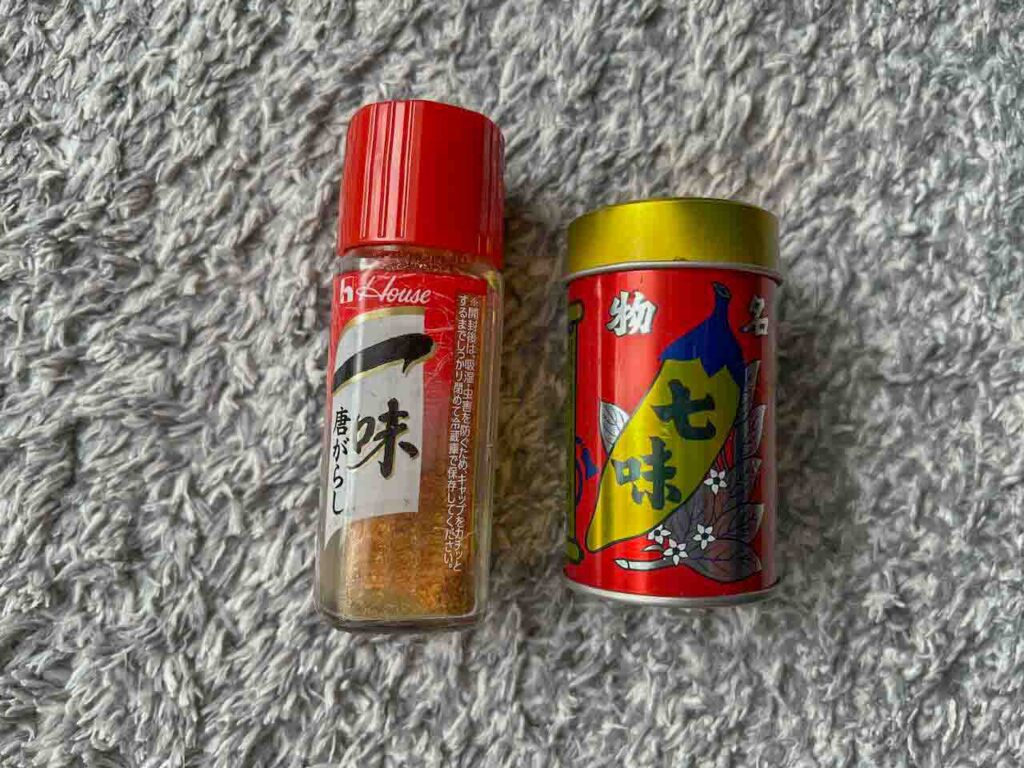Japanese cuisine is renowned for its balance of flavors — and when it comes to adding heat, two iconic chili powders stand at the center: shichimi togarashi and ichimi togarashi. Both enhance dishes with a spicy kick, but their differences in ingredients, complexity, and cultural roles reveal much about Japanese culinary philosophy.
In this guide, we’ll break down the unique characteristics of both seasonings, how to use them, and how they fit into Japan’s broader world of condiments.
For a full introduction to Japan’s seasoning culture, visit:
👉 The Complete Guide to Japanese Condiments: Unlocking the Flavors Behind Japan’s Culinary Mastery
Ingredient Profiles: Complex Blend vs. Pure Heat
Shichimi Togarashi — Japan’s Seven-Spice Blend
Shichimi togarashi (七味唐辛子) literally means “seven-flavor chili pepper.” Its complexity reflects Japan’s artistry in balancing multiple ingredients:
- Red chili pepper (togarashi): The base heat, rich in capsaicin.
- Sansho pepper: Provides a tingling, citrus-like numbing effect.
- Dried orange peel: Adds bright citrus aroma and limonene.
- Hemp seeds: Nutty, protein-rich, and texturally satisfying.
- Poppy seeds: Delicate crunch and healthy fats.
- Sesame seeds (white or black): Nutty depth and heart-friendly nutrients.
- Nori (seaweed): Infuses umami and oceanic minerals.
👉 For a deep dive into shichimi’s cultural and nutritional value:
Shichimi Togarashi: Japan’s Seven-Spice Symphony of Flavor, Health, and Culinary Tradition
Ichimi Togarashi — Pure Red Chili Simplicity
Ichimi togarashi (一味唐辛子) translates to “one-flavor chili pepper.” It contains:
- 100% finely ground red chili peppers, typically from Japanese varieties of Capsicum annuum.
Ichimi delivers a clean, focused heat without additional aromas or textures, ideal for dishes where pure spice is desired.
👉 Learn more about ichimi’s health benefits and role in Japanese food culture:
Ichimi Togarashi: Japan’s Pure Red Chili Powder That Fires Up Flavor and Wellness
Flavor and Culinary Uses: When to Reach for Each
Shichimi Togarashi: Versatile, Balanced, and Complex
Perfect for dishes where you want both heat and aromatic depth:
- Noodle soups (udon, soba, ramen): Enhances mild broths without overpowering.
- Grilled meats and yakitori: Complements savory char with citrus and nuttiness.
- Rice bowls (donburi): Adds complexity to otherwise simple bowls.
- Hot pots (nabe): Lends multiple layers of spice to communal winter meals.
- Tofu, salads, or even roasted vegetables: Provides both color and aroma.
Ichimi Togarashi: Direct, Bold Heat
Ideal for dishes that benefit from a pure, fiery edge:
- Ramen broths: Builds spice levels with precision.
- Stir-fries: Cuts through oil and richness.
- Stews and simmered dishes: Adds warming heat to heavier flavors.
- Tempura or grilled seafood: A clean burn to counter fried or fatty textures.
- Marinades: Infuses meats and sauces with controlled spiciness.
Nutritional Notes and Health Benefits
Both chili powders contain capsaicin, responsible for their spicy heat and associated health benefits:
- May boost metabolism and fat burning.
- Contains antioxidants (vitamin A, C, E) that support immunity.
- Promotes circulation and heart health in moderation.
- Provides mild anti-inflammatory effects.
⚠ However, excess consumption may irritate the stomach or worsen conditions like gastritis, reflux, or ulcers. As with all Japanese condiments: balance and mindfulness are key.
How to Choose Quality Shichimi and Ichimi
For Shichimi Togarashi:
- Choose blends listing all seven ingredients clearly.
- Seek freshly mixed products with bright aroma and color.
- Specialty producers like Yagenbori (Tokyo) or Shichimiya Honpo (Kyoto) are highly respected.
For Ichimi Togarashi:
- Look for 100% pure chili pepper with no fillers.
- High-quality ichimi often has a brilliant, uniform red color.
- Japanese domestic chili varieties are prized for their clean heat and mild fruitiness.
Cultural Significance
Both shichimi and ichimi reflect Japan’s broader culinary values:
- Shichimi = Harmony & complexity.
- Ichimi = Simplicity & purity.
Their widespread presence on Japanese restaurant tables — next to soy sauce, wasabi, or karashi — illustrates how Japanese diners fine-tune their meals with precision, rather than overwhelming spice.
👉 Related condiments to explore:
- Wasabi: The Health Benefits and Nutritional Value of Japan’s Iconic Pungent Root
- Karashi: Japan’s Pungent Mustard and Its Role in Japanese Cuisine
Conclusion
While they share a common chili base, shichimi togarashi and ichimi togarashi serve distinctly different roles in Japanese cooking. Understanding their unique qualities allows you to choose the perfect spice for any dish — whether you seek aromatic complexity or pure, focused heat.
By mastering both, you embrace the heart of Japanese seasoning: restraint, balance, and respect for each ingredient’s natural character.


